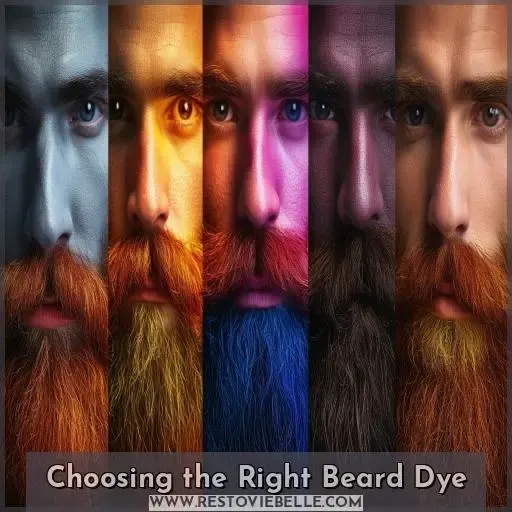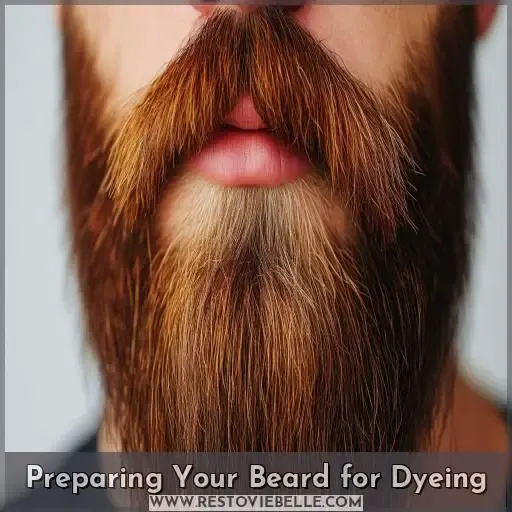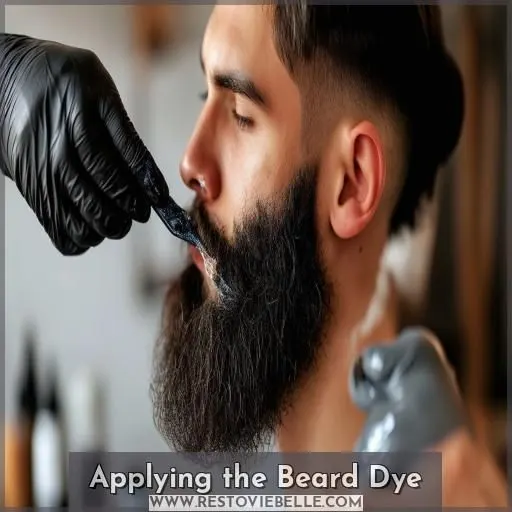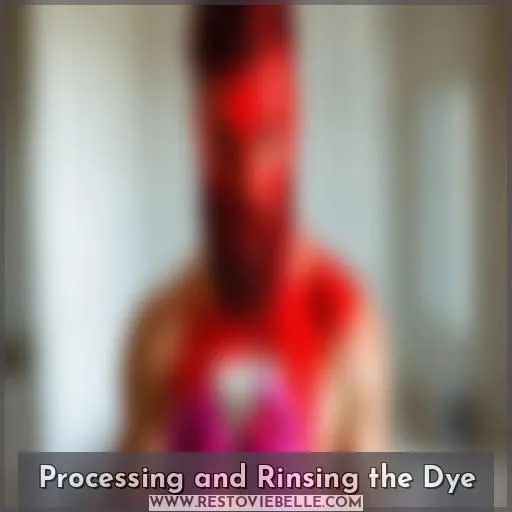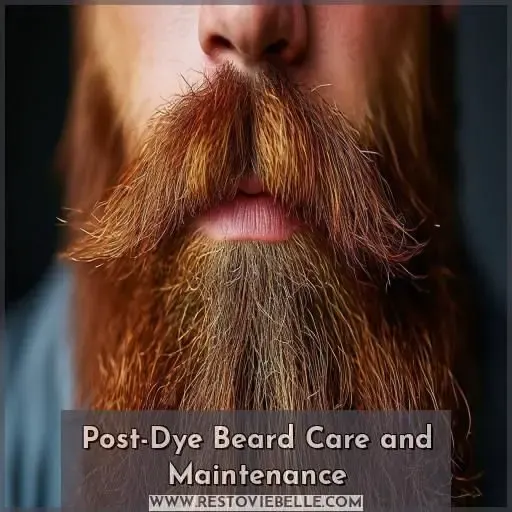This site is supported by our readers. We may earn a commission, at no cost to you, if you purchase through links.
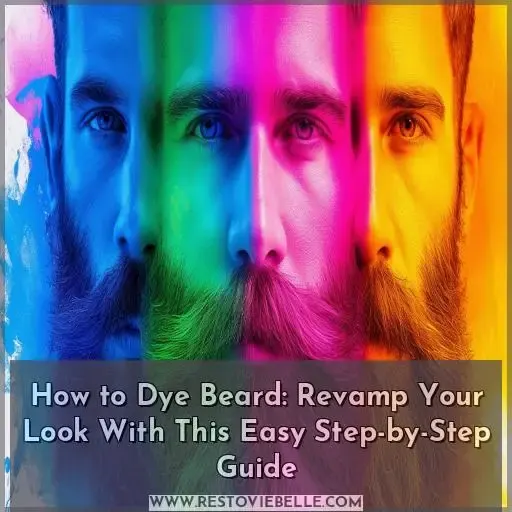 You’re ready to switch up your look by dyeing your beard, huh? Awesome!
You’re ready to switch up your look by dyeing your beard, huh? Awesome!
First things first, choose a dye that matches your natural hair color and checks the sensitivity box.
After cleansing and drying your facial mane, slap on some gloves and protect your skin.
Mix that solution per instructions, then paint it on section by section for full coverage.
Wait for the color magic to develop, rinse thoroughly, and bam – a brand new you!
Of course, maintaining that fresh dye job is key.
Nourish, moisturize and you’re golden.
But why settle for a sneak peek when you can keep reading for the full transformation?
Table Of Contents
Key Takeaways
- Beard dyeing is an art form, my friend – embrace the transformation with patience and precision, and you’ll rock a rugged yet distinguished look that exudes confidence.
- Don’t settle for a one-size-fits-all approach; match that dye shade to your natural hair color like a chameleon, and let your inner stylist shine through with a touch of individuality.
- Preparation is key, bro – cleanse, protect, and nourish your facial mane, treating it like a sacred ritual before unleashing the color magic.
- Maintenance is the name of the game, dude; with regular touch-ups and some TLC, that vibrant new hue will become your signature look, turning heads wherever you go.
How to Dye Beard?
To dye your beard, first choose a beard dye that matches your natural hair color and is suitable for your skin type. Then, follow the instructions to apply the dye evenly to your clean, dry beard, allowing it to process for the recommended time before rinsing thoroughly.
Choosing the Right Beard Dye
When dyeing your beard, matching the shade to your natural hair color is essential for a seamless, natural-looking result. However, you should also consider your skin’s sensitivity and opt for a gentle, allergy-safe formula to avoid any irritation or adverse reactions.
Matching Your Natural Hair Color
When choosing a beard dye, you’ll want to find a shade that complements your natural hair color.
Start by examining your roots and existing grays for an accurate match.
If you’re between shades, opt for a lighter option – it’s easier to deepen than lighten.
Consider natural alternatives like henna for those wary of chemicals.
Always perform a strand test to preview the color before fully applying.
And don’t forget – regular root touch-ups maintain an even, natural look as your beard grows out.
Considering Skin Sensitivity
You’ll also want to take into account any chemical sensitivities. Those with sensitive skin may opt for natural alternatives like henna to avoid potential irritation.
Always check ingredient lists and conduct a patch test before dyeing your beard to minimize allergy risks.
Properly protecting your skin around the beard area is essential during the dyeing process. With the right precautions, you can achieve a flawless beard dye job without jeopardizing your skin’s health.
Preparing Your Beard for Dyeing
Before applying beard dye, you’ll need to thoroughly cleanse your beard of any oils, dirt, or product buildup for the best possible color absorption. Next, protect your skin and surrounding surfaces from dye stains by applying a barrier cream or petroleum jelly to the skin around your beard area, and cover nearby surfaces with old towels or newspapers.
Cleansing and Drying
Before dyeing, give your beard a good cleanse with a gentle soap and water.
Avoid harsh chemicals that could strip natural oils.
Make certain your beard is dry before applying the dye – any moisture can affect the processing and result.
If your beard is particularly long or dense, you might need to cleanse and dry in sections for even coverage.
Keep in mind your beard’s growth rate too – cleansing a couple of days before dyeing ensures you’re not missing any new hair.
Protecting Skin and Surfaces
Protect your skin and surroundings before applying beard dye.
Wear gloves and an old shirt or apron to avoid staining clothes.
Place towels or newspapers over surfaces to catch drips.
Open windows for ventilation, as some dyes have strong odors.
If dyeing for the first time, do a patch test to check for allergies.
Use petroleum jelly or a thick cream around your beard to prevent skin staining.
With proper precautions, you can dye confidently while safeguarding yourself and your space from mishaps.
Applying the Beard Dye
Once you have your chosen beard dye color and your beard is prepped, it’s time to mix the dye solution carefully according to the product instructions. Apply the dye evenly to your beard using an applicator brush or a dye brush, ensuring complete coverage from the roots to the ends.
Mixing the Dye Solution
Your next step is to blend the dye solution seamlessly.
Adhere diligently to the guidelines for combining the appropriate chemical formula and dye quantity to obtain your preferred shade variation. Maintain the exact mixing ratio; any deviation could impact the application’s uniformity and overall beard appearance.
Proper mixing ensures maximum dye lifespan and prevents premature wash-off. With painstaking preparation, you’ll achieve the ideal beard color effortlessly.
Ensuring Even Coverage
Once the dye is mixed, you’ll want to make certain of even coverage for the best possible results. Here’s how:
- Do a patch test first to check for skin reactions
- Use an applicator brush or dye bottle for controlled application
- Work the dye into your beard in sections, applying liberally
- Don’t forget the edges and flyaways for a polished finish
With careful application, you’ll achieve a natural, age-defying look that exudes confidence. Remember, the key to a successful dye job lies in patience and precision – embrace the power of transformation!
Processing and Rinsing the Dye
As the recommended processing time elapses, you’ll need to closely monitor the beard’s color development to achieve your desired shade. Once the desired color is reached, thoroughly rinse the beard under cool water to remove any excess dye and prevent further darkening.
Monitoring Color Development
You’ve carefully applied the dye, but the true artistry lies in monitoring color development.
Regularly check the absorption rate, as beard porosity affects dye uptake. Permanent dyes require more vigilance, as they penetrate deeper.
For temporary dyes, assess if you’ve achieved the desired shade. Be mindful of color fading, which can impact your rugged, distinguished look.
With practice, you’ll master the nuances of beard grooming, shaping perceptions and defying age-old stigmas.
Embrace the power of transformation with every scrutinizing glance in the mirror.
Removing Excess Dye
Once the desired color develops, it’s time to rinse.
Carefully remove the dye to avoid staining your skin or damaging your beard’s texture.
Rinse thoroughly with cool water until the water runs clear.
You don’t want any residual dye causing irritation or premature color fading.
Use a color-protecting shampoo and conditioner to gently cleanse while preserving your new hue.
Be cautious – harsh chemicals can lead to dryness and breakage.
With proper rinsing, you can rock your revamped look without worrying about stains, burns, or an uneven mess.
Post-Dye Beard Care and Maintenance
After rinsing out the dye, you’ll want to nourish and condition your beard to keep it looking and feeling its best. Using a quality beard oil or conditioner will help lock in moisture, promote shine, and extend the longevity of your fresh new color.
Nourishing and Conditioning
After rinsing the dye, your beard needs some TLC. Nourish those freshly-colored strands with a quality conditioning treatment. This will:
- Restore moisture
- Soften coarse hair
- Tame frizz and flyaways
- Enhance shine and manageability
Look for beard oils, leave-in conditioners, and softening balms infused with nourishing ingredients like argan, jojoba, or coconut oils. Massage the product into your damp beard, focusing on the ends. With some pampering, that vibrant new shade will be the star of the show!
Extending Dye Longevity
To keep that vibrant beard color longer, use color-fixing shampoos and conditioners. Avoid harsh washing as it’ll strip the dye faster.
For sensitive skin, consider natural pigments like henna – they gently tint hairs over time.
Regular touch-ups every 3-4 weeks maintain rich, even coverage as new growth emerges. With proper care, you can rock that revamped look for months before needing a full re-dye.
Mastering these tips grants confidence and a liberating new style that commands attention.
Frequently Asked Questions (FAQs)
Can you use hair dye on your beard?
Like a canvas awaiting an artist’s touch, your beard can be transformed with hair dye. Yes, you can absolutely use hair dye on your beard for a fresh, vibrant look that boosts confidence.
What is the proper way to dye your beard?
Properly dyeing your beard involves cleansing, applying dye evenly, monitoring processing time, rinsing thoroughly, and maintaining with color-safe products. Follow instructions precisely for best, long-lasting results.
How long does beard dye last?
Like a chameleon’s fading colors, beard dye‘s vibrancy fades over weeks. But you control the fade rate – proper aftercare helps it last 2-4 weeks before needing a touch-up.
Can I dye my beard at home?
Yes, you can absolutely dye your beard at home. With the right products and preparation, you’ll awaken your inner stylist and achieve that desired look effortlessly.
How often should I dye my beard?
Yo, nowadays we’re all about that beard freedom! To maintain that fresh, vibrant hue, dye that majestic mane every 3-6 weeks – or more frequently for those grays fighting back. Consistency is key for a boss look.
Can I use regular hair dye?
While you can use regular hair dye, it’s not recommended for beards. Hair dyes contain harsh chemicals that can irritate facial skin. Instead, opt for beard dyes formulated specifically for coarse facial hair. They’re gentler and provide better coverage with natural-looking results.
Will dyeing make my beard brittle?
Dyeing shouldn’t make your beard brittle. Opt for high-quality dyes and follow instructions carefully. Condition after dyeing to nourish and strengthen hair strands. With proper care, you can achieve vibrant color without compromising beard health.
How long does beard dye last?
Ironically, the longevity of your beard dye depends on how quickly your facial hair grows. Generally, you’ll need to reapply every 4-6 weeks to maintain your desired shade.
Is beard dyeing suitable for all ages?
Beard dyeing is suitable for most ages. However, if you’re younger, dyeing may not be needed yet. For older gents, dyeing can revitalize and restore a youthful look. Ultimately, it’s a personal choice based on your goals and preferences.
Conclusion
By following this guide, you’ve successfully transformed your beard with a fresh new hue. Maintain your dyed look with proper nourishment and conditioning, and don’t hesitate to touch up those grays when needed. With the right products and techniques for how to dye beard, revamping your style becomes an easy routine. Embrace your vibrant new look with confidence!
